Step-by-step instructions: how to braid a bow into braids for storage
Onions are known for their taste and health benefits. It is added to many dishes, and in every home it is mandatory kept stock of onion heads. For a long time in Russia, onions were tied for the winter in long lush plaits for storage for the winter. This tradition is still alive today and is still popular.
In this article, we will tell you how to weave onions into braids for storage.
The content of the article
Why store onions in braids
Onion scythe is rightfully one of the best ways storage.
There are a number of reasons for this:
- Each bulb the spit is well ventilated, so the risk of disease and rotting is minimal.
- Vegetables are not impregnated with the smell of the container and retain their flavor.
- If the bulbs still start to rot, you can notice this in time and remove the rotten heads from the braid.
- Since all the onions are visible, it is easy to find the right head size for your dishes.
- It is more difficult for rodents to get to the scythes suspended from the ceiling and spoil the harvest.
- If you tie a bow with a pigtail for the winter, it will not take up much space.
- This is not only convenient, but also aesthetically pleasing: bulbs of different shades and flowers are braided into braids, thereby decorating the kitchen in an original way. They will fit especially well into country style.
The only drawback of weaving braids from a bow is labor intensity of work. But the convenience and beautiful appearance are worth spending several hours on tedious monotonous work.
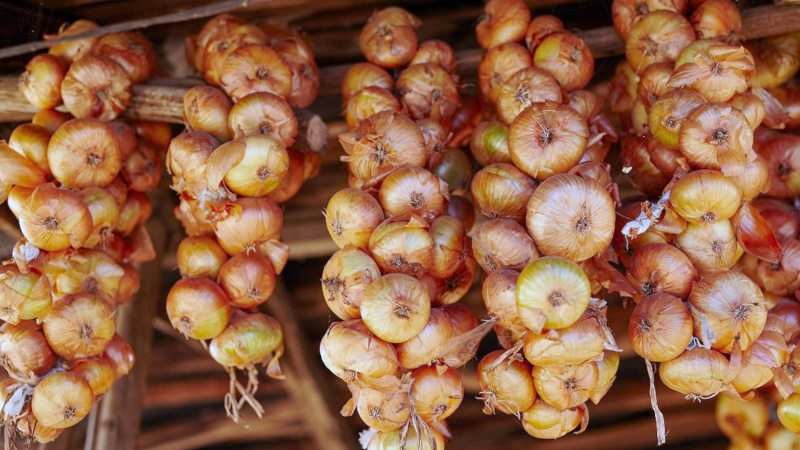
When is the best time to weave a bow
The fact that the onions are ripe will be indicated by their dried lower leaves. Once this happens, it is dug up and prepared for braiding. Each bulb is carefully poured in with a shovel or pitchfork so as not to damage it and pulled out of the ground. It is undesirable to touch the tops - it can easily come off, and for weaving it will need long and strong.
Reference. If the time is right, and the onions still don't ripen, trample the garden bed - walk on top of it or scoop up some of the soil from the bulbs. The procedure is carried out 2-3 weeks before harvesting.
It is better to make a pigtail from onions 3-4 days after digging and drying, when the tops have become soft, but have not yet dried completely.
Preparing the bow for braiding
To weave a bow braid for storage, prepare the turnips correctly.
This is done in three steps:
- drying;
- cleaning;
- sorting.
Before weaving the onions into a braid for the winter, the harvest is dried. It is best to leave it outdoors under the sun, spread out on nets, paper or cloth. The optimum temperature is 24-26 ° C, and the drying time is 3-4 days. The main thing is not to overdry - the tops must remain soft and elastic.
Important! The weather during drying should be warm and the air dry. If the days are rainy, dry the onions under a canopy or on the balcony. Excessive humidity will lead to rotting and crop death.
Dried onions are cleaned of soil residues and the roots are cut to 1-2 cm. This is not necessary, but braids with heads without roots will look neater.

The peeled bulbs are sorted, uneven and bruised, and bulbs of the same size are selected for each braid. If you want to make an unusual curly braid, divide the turnips by size and braid, making the transition from large to small.
It is not recommended to alternate them: it will be inconvenient to weave them and further monitor their safety.
How to knit onions in braids: step by step instructions with a photo
There are several patterns for weaving bow braids for the winter.For each method, you will need a rope made of any natural material with a length of 2-2.5 m or more. Due to the weight of the bulbs themselves, the braids turn out to be heavy, and without a strong base, such a pigtail will simply fall apart. Also, instead of a rope, use a bandage, tourniquet or twine.
Method 1
First of all, prepare the base for the braid - this is where you need a strong rope. Measure it so that, bent in half, it is no shorter than 2 m.
- Choose the bulb with the longest, strongest leaves. Tie it to the center of the rope, tightening the knot at the very base. You will have three tails - the tops of an onion and two ends of the rope.
- Using these ponytails, start braiding. Place a new onion head on each side, weaving it into the base and continuing the pigtail with its ponytail.
- Braid the braid until about 10-20 cm remains from the rope.It is important that the pigtail itself is not shorter than 2 m.
- With the remaining ends of the rope, tightly tie the last tops, and then make a strong loop out of them, for which you will hang the finished onion braid.
Weave the onions tightly so that the braids do not fall apart, and secure each at the very base of the leaves.
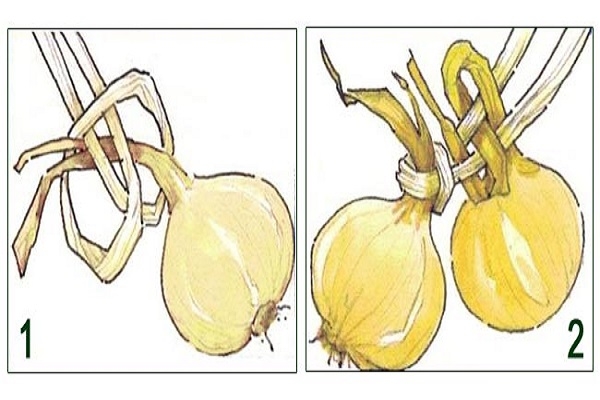
Method 2
We also need a base rope here. Measure it, as for the first method:
- Choose the largest bulbs with long feathers.
- Fold the string in half and secure the onion in the middle to create three pigtail ponytails.
- Begin weaving the bulbs evenly on each side.
- Tighten the rope into a strong knot every 3-4 heads.
- At the end, secure the braid with several knots and make a strong loop.
Method 3
This method requires bulbs with long, strong tops:
- Tie three onions together.
- Begin to braid the braids using their feathers, adding a new bulb on each side each time.
- Secure the tops of the last bulbs with a rope and make a strong loop.
Such a pigtail turns out to be short, since onion feathers without rope support will not support the weight of a large number of turnips.
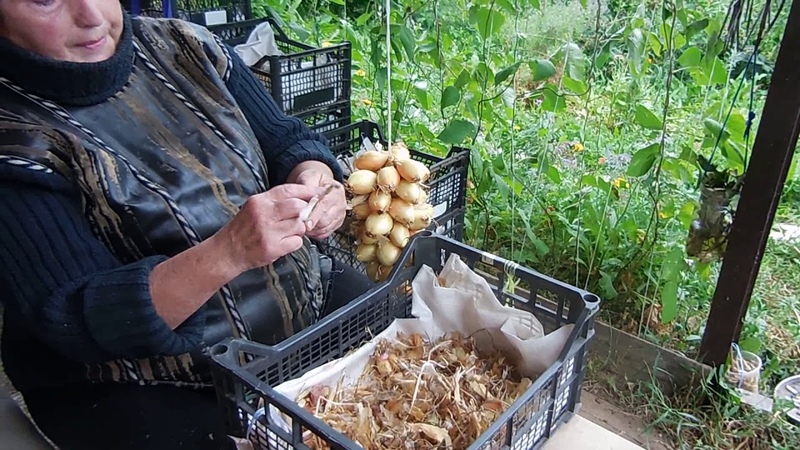
Method 4
Take the rope again and prepare the base as in the first and second methods:
- Tie the bulbs in pairs, use a rope or twist the tops together, leaving one bulb separate.
- As with the previous methods, secure the first turnip in the middle of the rope.
- Place pairs of bulbs tied together in turn between the ends of the rope, alternating them in one direction and the other.
- After every 2-3 pairs, tie the rope in a knot and secure this section of the braid.
- Fasten the entire braid with the ends of the rope and make a strong loop out of them.
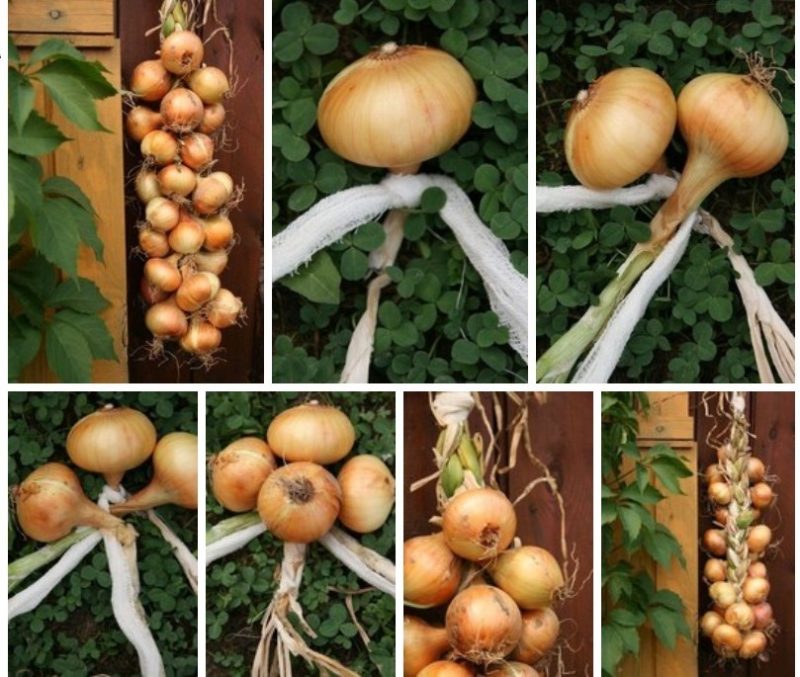
Pigtail from overdried bulbs
Even if you don't keep track of the bulbs and dry them too much, they will still make a strong pigtail:
- Remove all husks from the bulbs, leaving only dry feathers.
- Make a ring with a length of about 70 cm out of strong rope or tape and hang it on a hook or doorknob for more convenience.
- Braid two pairs of bulbs, fastening them together with a string or tying the tops themselves in a knot.
- At the very beginning of the ring, secure the first pair, then, criss-cross with the first, the second.
- Then take one onion at a time and wrap them with tops around a double rope. Distribute the heads evenly, alternating each side.
- Leave a loop of 7-10 cm on top, for which the pigtail will be suspended.
- If feather tips are sticking out of the finished braid, carefully trim them with scissors.
How to store onion braids
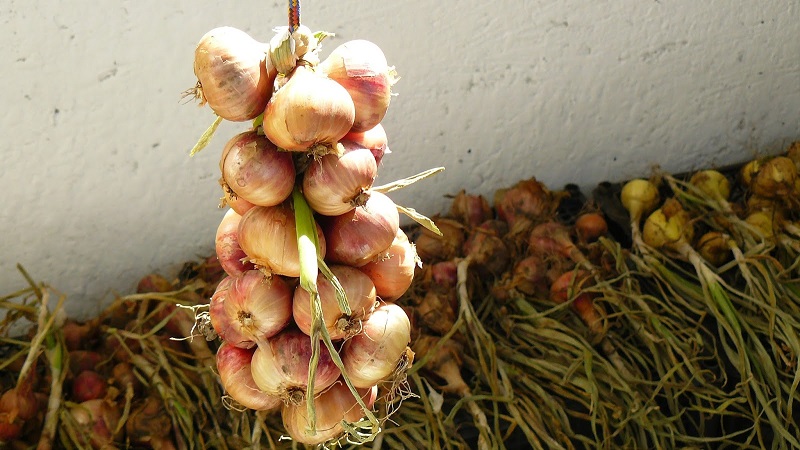
The ideal place to store onions is any dark, cool room with good air circulation, such as cellar or basement. The optimum temperature is 0… + 16 ° C. The room must be dry - with a humidity level above 60%, the bulbs will quickly deteriorate.
If onions will be stored in an apartment, hang them as far away from heaters and heat sources as possible. Storage temperature in an apartment - + 18 ... + 22 ° C.If the bulbs are eaten immediately, they will not have time to deteriorate.
Under these conditions, onions can be stored for up to 6 months, provided that each of the onions was initially whole and healthy.
Inspect all bulbs from time to time. If even one of them begins to rot, it is immediately removed from the pigtail to prevent further spread of the disease.
Conclusion
Braiding onions is the best way to harvest for the winter. The shelf life of turnips depends on the room chosen for storage, high-quality drying of the bulbs and proper harvesting. But if you take into account all the recommendations, onion pigtails will delight you with their beauty all winter and spring.